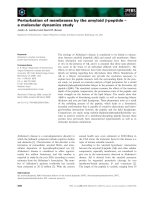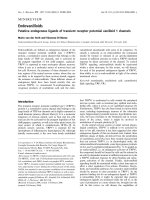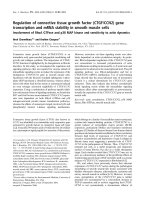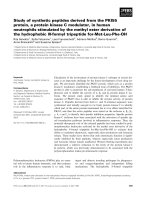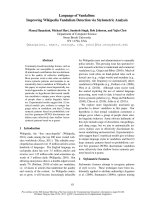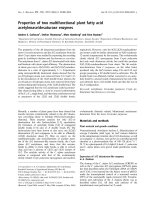Báo cáo khoa học: "Study of endogenous plant growth Douglas fir II. Gibberellin analysis" pptx
Bạn đang xem bản rút gọn của tài liệu. Xem và tải ngay bản đầy đủ của tài liệu tại đây (208.64 KB, 5 trang )
Study
of
endogenous
plant
growth
substances
in
Douglas
fir II.
Gibberellin
analysis
P.
Doumas
J.
Bianco
M.
Bonnet-Masimbert
1
Station
dAm6lioration
des
Arbres
Forestiers,
INRA
Ardon,
45160
Olivet,
and
2
Laboratoire
de
Physiotogie
Végétale,
Université
de
Nice,
06000
Nice,
France
Introduction
Flowering
in
Pinaceae
conifers
can
be
brought
about
by
the
application
of
less
polar
gibberellins
(GAs),
especially
GA4/7
applied
singly
or
in
combination
with
other
plant
growth
regulators
(such
as
naphthyl
acetic
acid)
or
culture
treatments,
such
as
high
temperature,
water
stress,
girdling
or
root-pruning
(Pharis
and
Ross,
1986).
GAs
seem
to
be
essential
in
the
flowering
induction
strategy.
It
is
therefore
important
to
know
the
endogenous
GAs
of
a
species
before
trying
to
interpret
any
physiological
role
of
endogenously
or
exogenously
applied
GAs.
The
level
of
endogenous
GAs
in
plant
tissues
is
generally
very
low
(1-10
ng/g
fresh
weight).
Consequently,
selective
methods
must
be
used
to
analyze
GAs.
One
course
of
action
is
to
use
selective
GA
immunoassays
to
detect
immunoreac-
tive
components
in
high
performance
liquid
chromatography
(HPLC)
eluates.
Weiler
and
his
coworkers
(Weiler
and
Wieczoreck,
1981;
Aztorn
and
Weiler,
1983a,
b)
have
shown
that
immunological
analyses
of
GAs
could
be
effective
and
promising.
We
have
developed
a
procedure,
com-
bining
HPLC
separation
and
enzyme-link-
ed
immunosorbent
assay
(ELISA),
which
can
recognize
a
limited
number
of
GAs.
We
have
analyzed
the
effect
of
flower-
inducing
treatments
on
GA
levels
from
juvenile
trees.
This
paper
reports
prelimi-
nary
results
on
the
analysis
of
several
GA-
like
substances
in
elongating
shoots
of
Douglas
fir
(Pseudotsuga
menziesii
Mirb.)
with
or
without
a
flower-inducing
treat-
ment,
independent
of
any
flowering
re-
sponse
on
such
juvenile
trees.
Materials
and
Methods
Plant
material
Experiments
were
performed
at
INRA,
Or]6ans,
France,
on
4
yr
old
cuttings
from
one
clone.
Plants
were
subjected
at
the
time
of
bud
burst
to
1
of
3
treatments:
1)
control;
2)
spray
of
GA4/7
(200
mg/1 )
plus
naphthyl
acetic
acid
(10
0
mg/1)
and
Aromox-C
(a
cationic
detergent,
0.002%
active
ingredient)
as
a
surfactant;
3)
stem
girdling
(2
half
girdles,
2
cm
apart,
close
to
the
branch
base).
Elongating
shoots
were
col-
lected
at
different
dates
during
the
floral
initia-
tion
time,
frozen
in
liquid
nitrogen,
lyophilized
and
ground.
Extraction
and purification
Shoot
samples
were
homogenized
in
80%
methanol
with
40
mg/I
butylated
hydroxy-tolu-
ene
(BHT)
as
anti-oxidant
and
extracted
at
4°C
for
36
h.
After
filtration
on
a
0.45
pm
Millipore
filter,
the
samples
were
loaded
onto
2
Sep-Pak
C18
cartridges
(Waters)
and
eluted
with
80%
methanol
(40
mg/I
BHT).
The
eluates
then
were
evaporated
under
vacuum
at
30°C.
The
resi-
dues
were
taken
up
with
500
I
II
of
me-
thanol-TEA
acetate
(20
mM)
(1/1),
pH
3.35,
and
were
injected
onto
the
HPLC
column.
High
performance
liquid
chromatography
The
extracts
were
purified
and
fractionated
with
a
reverse
phase
system
consisting
of
a
System
Gold
Beckman
connected
to
a
C18
column
(250
x
4.6
mm;
Merck
LiChrospher
100
RP-18,
5
pm)
eluted
with
mixtures
of
methanol
and
20
mM
TEA
acetate
buffer,
pH
3.35.
The
following
solvent
gradient
was
used:
8%
methanol
used
as
the
equilibrating
solvent;
a
linear
gradient
was
initiated
to
80%
over
37
min
and
then
increased
to
100%
over
10
min.
Flow
rate
was
1
ml/min.
Fractions
were
collected
every
minute
for
60
min,
methylated
and
the
GA-like
activity
was
tested
by
binding
it
to
anti-GA3
antibodies.
100
1
ELISA
Polyclonal
anti-GA3
antisera
were
prepared
by
immunizing
rabbits
with
GA3-BSA
conjugates
in
their
anhydride
form.
Samples
and
standards
were
methylated
with
ethereal
diazomethane
before
ELISA.
Microtitration
plates
were
coated
with
GA3-BSA
and
ELISA
was
performed
as
described
elsewhere
(Bianco
et
al.,
in
prepara-
tion).
In
order
to
increase
the
rapidity
of
the
test,
anti-GA3
antibodies
were
directly
labeled
with
peroxidase
enzyme
using
the
sodium
periodate
method.
Absence
of
addition
of
a
second
anti-
body,
such
as
peroxidase-labeled
sheep
anti-
rabbit
antibody
reduced
the
number
of
steps
and
improved
the
efficiency
of
the
method.
Results
ELISA
parameters
An
example
of
a
standard
curve
obtained
is
shown
in
Fig.
1.
The
detection
limit
is
40
fmol
of
GA3
methyl-ester
and
the
working
range
of
the
assay
is
between
about
50
fmol
and
50
pmol
of
GA3
methyl-ester
per
well.
The
anti-GA3
antibodies
cross-react
with
GA1, GAS,
GA7,
GA8
and
GA13.
Plant
sample
analyses
Elution
of
available
authentic
tritiated
GA
standards
(GA3,
GA4,
GAS,
GA8,
GA9,
GA20)
from
a
reverse
phase
HPLC
system
is
shown
in
Fig.
2.
Under
our
con-
ditions,
we
were
able
to
separate
several
GAs
in
a
timed
program
of
50
min.
ELISA
of
individual
fractions
from
plant
extract
HPLC
eluates
confirmed
the
presence
of
several
peaks
of
cross-reactive
material
(Fig.
3).
In
the
shoot
sample
from
the
control
trees
(Fig.
3A),
5
immunoreactive
peaks
appeared
which
have,
respectively,
a
retention
time
of
8,
16, 21,
27
and
46
min.
Only
3
of
them
co-eluted
with
GA
standards:
GA8
(8
min),
GA3
(15-16
min)
and
GA5/20
(26-29
min).
The
profile
of
GA-like
substances
in
the
extract
from
GA4/7-sprayed
plants
(Fig.
3B)
shows
several
immunoreactive
peaks
at
7,
16,
22,
28,
32,
37,
42
and
46
min.
Some
of
them
co-chromatographed
with
standards,
e.g.,
GA8,
GA3,
GA5/20,
GA4
(39 min)
and
GA9
(41
min).
In
the
shoot
extract
from
stem-girdled
trees
(Fig.
3C),
only
3
GA-like
peaks
were
present
at
15,
21
and
46
min,
one
of
which
co-migrated
with
the
GA3
standard.
Culture
treatments
induce
a
dramatic
increase
of
GA
levels.
Discussion
and
Conclusion
The
results
described
above
on
the
endo-
genous
GAs
of
Douglas
fir
shoots
provide
a
clear
illustration
of
the
utility
of
a
com-
bined
HPLC-ELISA
detection
system
for
GAs.
This
method
allows
rapid,
specific
and
sensitive
detection,
identification
and
quantification
of
some
GAs.
C18
purifica-
tion
and
directly
labeled
antibodies
de-
crease
the
number
of
steps
required
and
improve
the
rapidity
of
the
method.
These
preliminary
results
suggest
that
untreated
shoots
contain
at
least
5
dif-
ferent
GAs
and
that
flower-induction
treat-
ments
cause
changes
in
GA
patterns
and
tremendous
increases
of
GA
levels.
The
most
interesting
result
was
obtained
for
shoot
samples
from
GA4/7-sprayed
trees.
This
treatment
induced
an
important
modi-
fication
of
the
original
GA
pattern
ob-
served.
This
result
suggests
that
GA4/7
is
directly
metabolized
in
treated
shoots
and
the
quantity
of
more
polar
GAs
is
in-
creased,
as
proposed
by
Pharis
et
al.,
(1987).
Thus,
GA4/7
either
may
have
a
direct
role
in
flowering
or
it
may
be
an
important
precursor
in
the
metabolism
of
other
flower-inducing
GAs.
This
study
represents
only
a
preliminary
assessment.
Long-term
analysis
of
GAs
related
to
flowering
and
affected
by
culture
treatments
must
continue.
References
Atzorn
R.
&
Weiler
E.W.
(1983a)
The
immu-
noassay
of
gibberellins.
I.
Radioimmunoassay
for
the
gibberellins
A1,
A3, A4,
A7,
A9
and
A20.
Planta 159, 1-6
Atzorn
R.
&
Weiler
E.W.
(1983b)
The
immu-
noassay
of
gibberellins.
II.
Quantitation
of
GA3,
GA4
and
GA7
by
ultrasensitive
solid-phase
enzyme
immunoassays.
Planta
159,
7-11
1
Pharis
R.P.
&
F3oss
S.D.
(198F}
Hormonal
pro-
motion
of
flowering
in
Pinaceae
family
conifers.
tn!
flandbaok
on
Flowering-
V
al.
5.
avely
A.,
ed.!,
CR!
Press,
Baca
Ra1on, Fl,pp.
269-286
htaaris
R.P.,,
Webber
J.E.
&
Ross
S.D,
(1987)
The
promotion
of
flowering
in
forest
trees
by
gibberellin
4/7
and
cultural
treatments:
a
review
of
the
possible
mechanisms.
For.
iE?oo/.
Man-
age.
1:9,
65-84
Vrieiler
E.W.
&
Wieczotek
U,
(1981!
Determina-
tion
of
fentomole
quantities
of
gibberellic
acid
by
radioimmunoassay.
Planta
152,159-167
